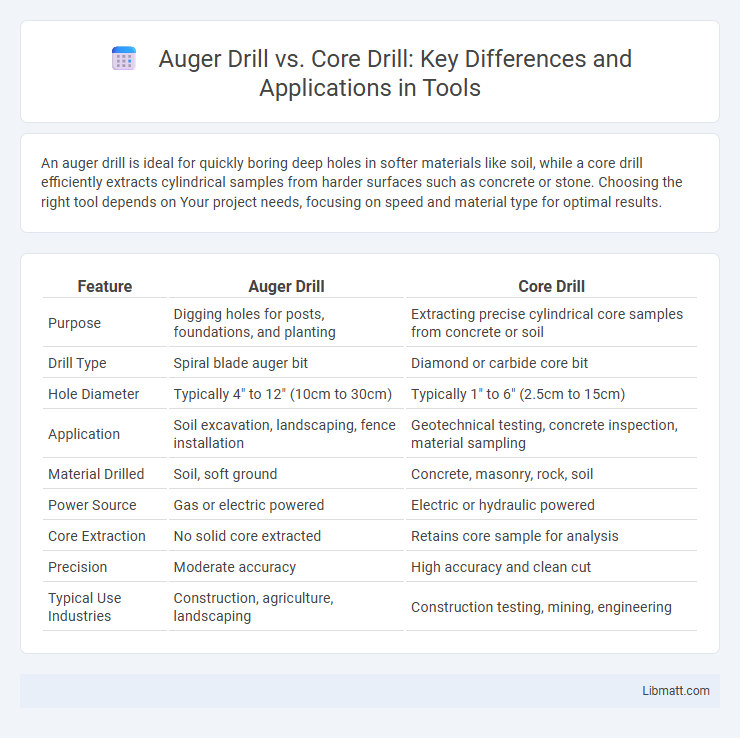An auger drill is ideal for quickly boring deep holes in softer materials like soil, while a core drill efficiently extracts cylindrical samples from harder surfaces such as concrete or stone. Choosing the right tool depends on Your project needs, focusing on speed and material type for optimal results.
Table of Comparison
| Feature | Auger Drill | Core Drill |
|---|---|---|
| Purpose | Digging holes for posts, foundations, and planting | Extracting precise cylindrical core samples from concrete or soil |
| Drill Type | Spiral blade auger bit | Diamond or carbide core bit |
| Hole Diameter | Typically 4" to 12" (10cm to 30cm) | Typically 1" to 6" (2.5cm to 15cm) |
| Application | Soil excavation, landscaping, fence installation | Geotechnical testing, concrete inspection, material sampling |
| Material Drilled | Soil, soft ground | Concrete, masonry, rock, soil |
| Power Source | Gas or electric powered | Electric or hydraulic powered |
| Core Extraction | No solid core extracted | Retains core sample for analysis |
| Precision | Moderate accuracy | High accuracy and clean cut |
| Typical Use Industries | Construction, agriculture, landscaping | Construction testing, mining, engineering |
Introduction to Auger Drill and Core Drill
Auger drills use a helical screw blade to remove earth quickly for soil sampling and shallow holes, making them ideal for geotechnical and environmental investigations. Core drills extract cylindrical rock or concrete samples with a diamond-tipped bit, essential for structural analysis and material testing in construction and mining. Both tools play critical roles in subsurface exploration but serve distinct functions based on depth, material, and sample requirements.
Key Differences Between Auger Drill and Core Drill
Auger drills are primarily designed for drilling deep, narrow holes in soil or soft materials using a helical screw blade to remove debris, making them ideal for earthworks and fence post installation. Core drills use diamond or carbide-tipped bits to cut precise, cylindrical samples from hard materials like concrete or rock, essential for geological analysis and construction testing. While auger drills excel in rapid, large-volume soil removal, core drills provide detailed material sampling with minimal structural damage.
How Auger Drills Work: Applications and Features
Auger drills use a helical screw blade to remove earth materials by rotating into the ground, making them ideal for soil sampling, agriculture, and construction projects requiring efficient, deep hole drilling. Their lightweight design and portability allow easy operation in diverse terrains, while the continuous soil extraction minimizes clogging and speeds up the drilling process. Your choice of an auger drill benefits applications needing quick, clean holes in softer substrates compared to the more specialized core drill used for extracting cylindrical rock or concrete samples.
Core Drill Mechanism: Uses and Advantages
Core drills utilize a hollow cylindrical bit to extract a solid core sample from materials like concrete, rock, or soil, enabling precise analysis of the internal structure. This mechanism provides highly accurate and clean samples essential for geological surveys, construction quality assessments, and material testing. The core drill's capability to preserve the integrity of the sample while minimizing damage to surrounding areas offers significant advantages in both research and practical applications.
Material Suitability: Auger vs. Core Drilling
Auger drills excel in penetrating soft to medium soil and loose materials, making them ideal for geotechnical and environmental sampling in sandy, clayey, or silty substrates. Core drills are better suited for hard rock, concrete, and dense materials, extracting cylindrical samples with intact stratigraphy crucial for structural analysis and mineral exploration. Material suitability directly influences drill bit selection, drilling speed, and sample integrity in subsurface investigations.
Speed and Efficiency Comparison
Auger drills typically offer faster drilling speeds in softer soils due to their simple design and rapid soil removal capabilities, making them efficient for shallow boreholes. Core drills, while slower, provide precision and the ability to extract intact cylindrical samples, essential for geological analysis or concrete inspection. The choice between auger and core drilling depends on project requirements, balancing speed with sample integrity.
Cost Considerations: Auger Drills vs. Core Drills
Auger drills typically cost less than core drills due to simpler design and lower material expenses, making them ideal for budget-conscious projects requiring boreholes for soil sampling or small-diameter holes. Core drills involve higher costs driven by advanced diamond-tipped bits, specialized equipment, and the ability to extract intact cylindrical samples from concrete or rock, essential in geotechnical or construction applications. Maintenance and operation expenses also differ, with core drills often requiring more skilled operators and frequent bit replacements, impacting overall project budgets.
Precision and Accuracy in Drilling
Auger drills deliver rapid excavation with moderate precision, ideal for softer soils where accuracy is less critical. Core drills excel in precision and accuracy, extracting intact cylindrical samples essential for geological analysis or structural testing. Your choice depends on whether exact sampling or efficient soil removal is the primary objective.
Maintenance and Durability Factors
Auger drills require regular sharpening of their helical blades and frequent cleaning to prevent material buildup, ensuring long-lasting performance especially in softer soils. Core drills, with their diamond-tipped bits, demand careful handling and timely replacement of worn segments to maintain cutting efficiency and durability in hard rock conditions. Your choice should consider these maintenance routines, as auger drills are generally easier to maintain but less durable in tough environments compared to core drills.
Choosing the Right Drill for Your Project
Choosing between an auger drill and a core drill depends on the specific requirements of your project, such as the material type and desired hole size. Auger drills excel in drilling deep, narrow holes in wood and softer soils, offering quick and efficient excavation. Core drills are ideal for creating precise, large-diameter holes in concrete, stone, or masonry, ensuring clean edges for installations like plumbing or electrical conduits.
Auger drill vs core drill Infographic

 libmatt.com
libmatt.com